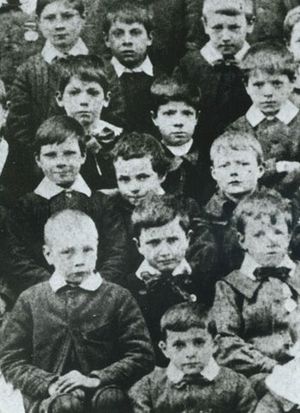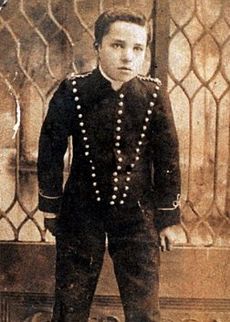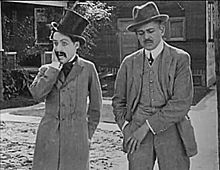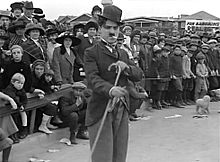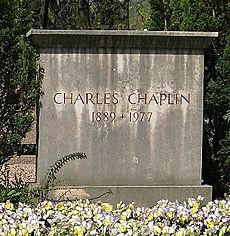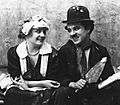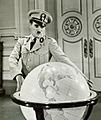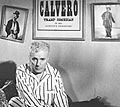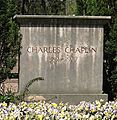Charlie Chaplin facts for kids
Quick facts for kids
Charlie Chaplin
|
|
|---|---|
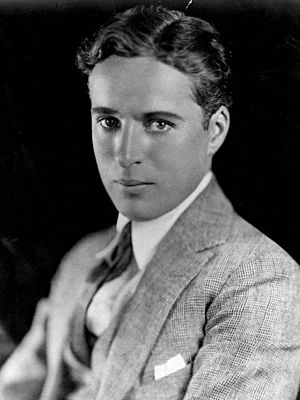
Chaplin in the early 1920s
|
|
| Born |
Charles Spencer Chaplin
16 April 1889 London, England
|
| Died | 25 December 1977 (aged 88) Corsier-sur-Vevey, Switzerland
|
| Burial place | Cimetière de Corsier-sur-Vevey, Corsier-sur-Vevey, Switzerland |
| Occupation |
|
| Years active | 1899–1975 |
|
Works
|
Full list |
| Spouse(s) |
|
| Children | 11, including Charles, Sydney, Geraldine, Michael, Josephine, Victoria, Eugene and Christopher |
| Parent(s) | Charles Chaplin Sr. Hannah Hill |
| Relatives | Chaplin family |
| Signature | |
Sir Charles Spencer Chaplin KBE (16 April 1889 – 25 December 1977) was an English comic actor, filmmaker, and composer who rose to fame in the era of silent film. He became a worldwide icon through his screen persona, the Tramp, and is considered one of the film industry's most important figures. His career spanned more than 75 years, from childhood in the Victorian era until a year before his death in 1977.
Contents
Early years
Charles Spencer Chaplin Jr. was born on 16 April 1889 to Hannah Chaplin (née Hill) and Charles Chaplin Sr. His paternal grandmother came from the Smith family, who belonged to Romani people. There is no official record of his birth, although Chaplin believed he was born at East Street, Walworth, in South London.
At the time of his birth, Chaplin's parents were both music hall entertainers. Hannah, the daughter of a shoemaker, had a brief and unsuccessful career under the stage name Lily Harley, while Charles Sr., a butcher's son, was a popular singer. Although they never divorced, Chaplin's parents were estranged by around 1891.
Chaplin's childhood in London was one of poverty and hardship. His father was absent and his mother struggled financially — he was sent to a workhouse twice before age nine. Charlie and his half-brother, Sidney, spent most of their childhood in orphanages, where they often went hungry and were beaten if they misbehaved. His mother wanted him to finish school, but, by age 13 he had abandoned education. When he was 14, his mother was committed to a mental asylum. She never fully recovered and died in 1928.
Career
Chaplin began performing at early age, touring music halls and later working as a stage actor and comedian.
His first important work came when he joined The Eight Lancashire Lads. In 1900, his brother Sydney helped him get the role of a comic cat in the pantomime Cinderella. In 1903 he was in a play called “Jim: A Romance of Cockayne”. Chaplin was in Casey's 'Court Circus' variety show. The next year, he became a clown in Fred Karno's 'Fun Factory' comedy company.
At 19, he was signed to the Fred Karno company, which took him to the United States. He was scouted for the film industry and began appearing in 1914 for Keystone Studios. He soon developed the Tramp persona and attracted a large fan base.
During 1915, Chaplin became a cultural phenomenon. Shops were stocked with Chaplin merchandise, he was featured in cartoons and comic strips, and several songs were written about him. In July, a journalist for Motion Picture Magazine wrote that "Chaplinitis" had spread across America. As his fame grew worldwide, he became the film industry's first international star. When the Essanay contract ended in December 1915, Chaplin, fully aware of his popularity, requested a $150,000 signing bonus from his next studio. He received several offers, including Universal, Fox, and Vitagraph, the best of which came from the Mutual Film Corporation at $10,000 a week.
He directed his own films and continued to hone his craft as he moved to the Essanay, Mutual, and First National corporations. By 1918, he was one of the world's best-known figures.
In 1919, Chaplin co-founded distribution company United Artists, which gave him complete control over his films. His first feature-length film was The Kid (1921), followed by A Woman of Paris (1923), The Gold Rush (1925), and The Circus (1928). He initially refused to move to sound films in the 1930s, instead producing City Lights (1931) and Modern Times (1936) without dialogue.
His first sound film was The Great Dictator (1940), which satirised Adolf Hitler. The 1940s were marked with controversy for Chaplin, and his popularity declined rapidly. He was accused of communist sympathies. An FBI investigation was opened, and Chaplin was forced to leave the U.S. and settle in Switzerland. He abandoned the Tramp in his later films, which include Monsieur Verdoux (1947), Limelight (1952), A King in New York (1957), and A Countess from Hong Kong (1967).
Chaplin wrote, directed, produced, edited, starred in, and composed the music for most of his films. He was a perfectionist, and his financial independence enabled him to spend years on the development and production of a picture. His films contain social and political themes, as well as autobiographical elements.
He received an Honorary Academy Award for "the incalculable effect he has had in making motion pictures the art form of this century" in 1972, as part of a renewed appreciation for his work. He continues to be held in high regard, with The Gold Rush, City Lights, Modern Times, and The Great Dictator often ranked on lists of the greatest films.
Chaplin also composed scores for his films. Chaplin's compositions produced three popular songs. "Smile", composed originally for Modern Times (1936) and later set to lyrics by John Turner and Geoffrey Parsons, was a hit for Nat King Cole in 1954. For Limelight, Chaplin composed "Terry's Theme", which was popularised by Jimmy Young as "Eternally" (1952). Finally, "This Is My Song", performed by Petula Clark for A Countess from Hong Kong (1967), reached number one on the UK and other European charts. Chaplin also received his only competitive Oscar for his composition work, as the Limelight theme won an Academy Award for Best Original Score in 1973 following the film's re-release.
Assassination attempt
Chaplin was the target of an assassination attempt which took the life of Prime Minister of Japan Inukai Tsuyoshi.
On 15 May 1932, Prime Minister Inukai Tsuyoshi was shot by eleven young naval officers (most were just turning twenty years of age) in the prime minister's residence. The original assassination plan had included killing Chaplin who had arrived in Japan on 14 May 1932, at a reception for Chaplin, planned by Prime Minister Inukai. When the prime minister was killed, his son Inukai Takeru was watching a sumo wrestling match with Charlie Chaplin, which probably saved both their lives.
Personal life
Charlie Chaplin was married four times in his lifetime and had a total of eleven children with three of his wives. Here is a breakdown of his marriages and children:
- Mildred Harris: Chaplin's first marriage was to 16-year-old actress Mildred Harris in 1918
They had one son named Norman Spencer Chaplin, who was born in 1919 but died three days later. The marriage ended in 1920
- Lita Grey: Chaplin's second marriage was to actress Lita Grey in 1924.
They had two sons named Charles Chaplin Jr. and Sydney Chaplin. The marriage ended in 1927.
- Paulette Goddard: Chaplin's third marriage was to actress Paulette Goddard in 1936.
They did not have any children together. The marriage ended in 1942.
- Oona O'Neill: Chaplin's fourth and final marriage was to Oona O'Neill in 1943.
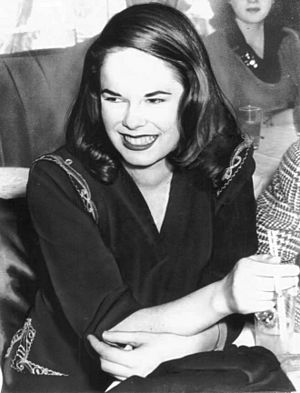
They had eight children together: Geraldine, Michael, Josephine, Victoria, Eugene, Jane, Annette, and Christopher. The couple remained married until Chaplin's death in 1977.
Chaplin's children went on to have their own careers in the entertainment industry, with some of them appearing in films alongside their father
Later years
Chaplin had a series of minor strokes in the late 1960s, which marked the beginning of a slow decline in his health. Although Chaplin still had plans for future film projects, by the mid-1970s he was very frail. He experienced several further strokes, which made it difficult for him to communicate, and he had to use a wheelchair.
His final projects were compiling a pictorial autobiography, My Life in Pictures (1974) and scoring A Woman of Paris for re-release in 1976. He also appeared in a documentary about his life, The Gentleman Tramp (1975), directed by Richard Patterson. In the 1975 New Year Honours, Chaplin was awarded a knighthood by Queen Elizabeth II, though he was too weak to kneel and received the honour in his wheelchair.
Death
By October 1977, Chaplin's health had declined to the point that he needed constant care. In the early morning of Christmas Day 1977, Chaplin died at home after having a stroke in his sleep. He was 88 years old. The funeral, on 27 December, was a small and private Anglican ceremony, according to his wishes.
Chaplin was interred in the Corsier-sur-Vevey cemetery. On March 1, 1978, his body was stolen by a small group of Swiss people. They were trying to get money from Chaplin’s family. This plan didn’t work. The criminals were caught, and Charlie’s body was found 11 weeks later near Lake Geneva. He was buried under concrete to prevent further incidents.
Legacy
Chaplin's legacy is managed on behalf of his children by the Chaplin office, located in Paris. Their central archive is held at the archives of Montreux, Switzerland and scanned versions of its contents, including 83,630 images, 118 scripts, 976 manuscripts, 7,756 letters, and thousands of other documents, are available for research purposes at the Chaplin Research Centre at the Cineteca di Bologna. The photographic archive, which includes approximately 10,000 photographs from Chaplin's life and career, is kept at the Musée de l'Elysée in Lausanne, Switzerland.
The British Film Institute has also established the Charles Chaplin Research Foundation, and the first international Charles Chaplin Conference was held in London in July 2005. Elements for many of Chaplin's films are held by the Academy Film Archive as part of the Roy Export Chaplin Collection.
Charlie Chaplin quotes
- "Life can be wonderful if you're not afraid of it. All it needs is courage, imagination ... and a little dough."
- "Imagination means nothing without doing."
- "You’ll never find rainbows if you’re looking down."
- "Let us strive for the impossible. The great achievements throughout history have been the conquest of what seemed the impossible."
Commemorations
- In London, a statue of Chaplin as the Tramp, sculpted by John Doubleday and unveiled in 1981, is located in Leicester Square.
- The city also includes a road named after him in central London, "Charlie Chaplin Walk", which is the location of the BFI IMAX.
- There are nine blue plaques memorialising Chaplin in London, Hampshire, and Yorkshire.
- In Canning Town, East London, the Gandhi Chaplin Memorial Garden, opened by Chaplin's granddaughter Oona Chaplin in 2015, commemorates the meeting between Chaplin and Mahatma Gandhi at a local house in 1931.
- The Swiss town of Vevey named a park in his honour in 1980 and erected a statue there in 1982.
- In 2011, two large murals depicting Chaplin on two 14-storey buildings were also unveiled in Vevey.
- Chaplin has also been honoured by the Irish town of Waterville, where he spent several summers with his family in the 1960s.
- A minor planet, 3623 Chaplin (discovered by Soviet astronomer Lyudmila Karachkina in 1981) is named after Charlie.
- Throughout the 1980s, the Tramp image was used by IBM to advertise their personal computers.
- Chaplin's 100th birthday anniversary in 1989 was marked with several events around the world, and on 15 April 2011, a day before his 122nd birthday, Google celebrated him with a special Google Doodle video on its global and other country-wide homepages.
Museum
Chaplin's final home, Manoir de Ban in Corsier-sur-Vevey, Switzerland, has been converted into a museum named "Chaplin's World". It opened on 17 April 2016 after fifteen years of development, and is described by Reuters as "an interactive museum showcasing the life and works of Charlie Chaplin". On the 128th anniversary of his birth, a record-setting 662 people dressed as the Tramp in an event organised by the museum.
Awards and recognition
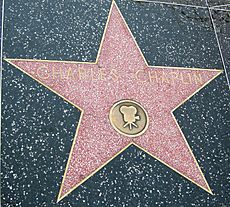
Chaplin received many awards and honours, especially later in life. In the 1975 New Year Honours, he was appointed a Knight Commander of the Order of the British Empire (KBE). He was also awarded honorary Doctor of Letters degrees by the University of Oxford and the University of Durham in 1962. In 1965, he and Ingmar Bergman were joint winners of the Erasmus Prize and, in 1971, he was appointed a Commander of the National Order of the Legion of Honour by the French government.
From the film industry, Chaplin received a special Golden Lion at the Venice Film Festival in 1972, and a Lifetime Achievement Award from the Lincoln Center Film Society the same year. The latter has since been presented annually to filmmakers as The Chaplin Award. Chaplin was given a star on the Hollywood Walk of Fame in 1972, having been previously excluded because of his political beliefs.
Chaplin received three Academy Awards: an Honorary Award for "versatility and genius in acting, writing, directing, and producing The Circus" in 1929, a second Honorary Award for "the incalculable effect he has had in making motion pictures the art form of this century" in 1972, and a Best Score award in 1973 for Limelight (shared with Ray Rasch and Larry Russell). He was further nominated in the Best Actor, Best Original Screenplay, and Best Picture (as producer) categories for The Great Dictator, and received another Best Original Screenplay nomination for Monsieur Verdoux. In 1976, Chaplin was made a Fellow of the British Academy of Film and Television Arts (BAFTA).
Six of Chaplin's films have been selected for preservation in the National Film Registry by the United States Library of Congress: The Immigrant (1917), The Kid (1921), The Gold Rush (1925), City Lights (1931), Modern Times (1936), and The Great Dictator (1940).
Interesting facts about Charlie Chaplin
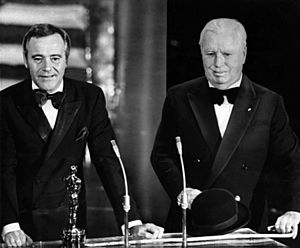
- Chaplin had two maternal half-brothers - Sydney John Hill and George Wheeler Dryden, fathered by the music hall entertainer Leo Dryden.
- He first started acting at age five. He acted in a music hall in 1894, standing in for his mother.
- Chaplin cited his mother as the greatest influence on his acting career. When Charlie was a child, he was kept in bed for many weeks from a bad illness. At night, his mother would sit at the window and act out what was going on outside.
- At age 26, Chaplin became one of the highest paid people in the world, with a contract of $670,000 a year.
- On 6 July 1925, Chaplin became the first movie star to be featured on a Time magazine cover.
- Chaplin developed a passion for music as a child and taught himself to play the piano, violin, and cello.
- Chaplin began using a synchronised orchestral soundtrack – composed by himself – for City Lights (1931). He thereafter composed the scores for all of his films, and from the late 1950s to his death, he scored all of his silent features and some of his short films.
- As Chaplin was not a trained musician, he could not read sheet music and needed the help of professional composers, such as David Raksin, Raymond Rasch and Eric James, when creating his scores.
- At the 1st Academy Awards, Chaplin was given a special trophy "For versatility and genius in acting, writing, directing and producing The Circus".
- In 1972, the Academy of Motion Picture Arts and Sciences offered Chaplin an Honorary Award". At the Academy Awards gala, he was given a 12-minute standing ovation, the longest in the academy's history.
- In 1976 he was given the BAFTA Academy Fellowship Award, a lifetime achievement award.
- Myths say, Chaplin once entered in a Charlie Chaplin look-a-like contest. Chaplin lost the contest.
- In 1971, he was made a Commander of the National Order of the Legion of Honour at the Cannes Film Festival.
- In 1972, he was honoured with a special award by the Venice Film Festival.
- Chaplin is described by the British Film Institute as "a towering figure in world culture", and was included in Time magazine's list of the "100 Most Important People of the 20th Century".
- In 1999, the American Film Institute ranked Chaplin as the 10th greatest male star of Classic Hollywood Cinema.
- Chaplin's most iconic character is the Tramp. In 2006, a bowler hat and a bamboo cane that were part of the Tramp's costume were bought for $140,000 in a Los Angeles auction.
- Chaplin helped inspire the cartoon characters Felix the Cat and Mickey Mouse.
Movies
|
|
Images for kids
-
The Kid (1921), with Jackie Coogan, combined comedy with drama and was Chaplin's first film to exceed an hour.
-
The Tramp resorts to eating his boot in The Gold Rush (1925).
-
Lita Grey, whose bitter divorce from Chaplin caused a scandal
-
Chaplin satirised Adolf Hitler in The Great Dictator (1940).
-
Limelight (1952) was a serious and autobiographical film for Chaplin. His character, Calvero, is an ex–music hall star (described in this image as a "Tramp Comedian") forced to deal with his loss of popularity.
-
Chaplin (right) receiving his Honorary Academy Award from Jack Lemmon in 1972. It was the first time he had been to the United States in twenty years.
-
A 1922 image of Charlie Chaplin Studios, where all of Chaplin's films between 1918 and 1952 were produced
-
Chaplin as the Tramp, cinema's "most universal icon", in 1915
-
A Chaplin impersonator and his audience in San Sebastián, Spain, in 1919
-
Chaplin memorial plaque in St Paul's, Covent Garden, London
-
Star on the Hollywood Walk of Fame at 6755 Hollywood Boulevard.
See also
 In Spanish: Charles Chaplin para niños
In Spanish: Charles Chaplin para niños


